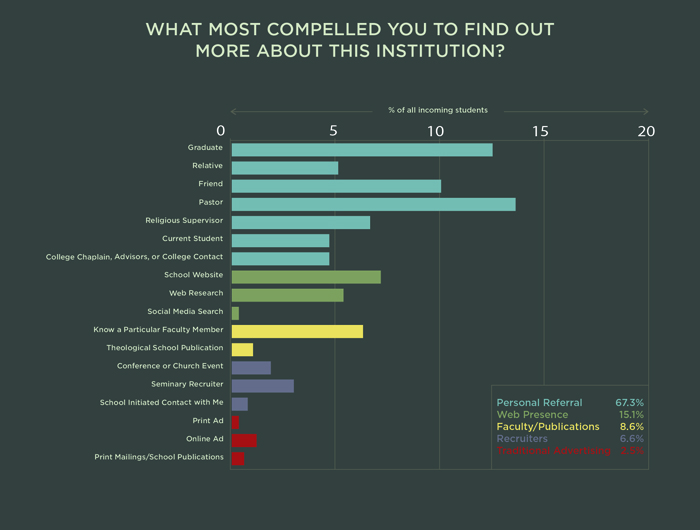January 8, 2015
In Trust has asked me to provide for its quarterly publication snapshots of data about the industry and insights we might find or actions we could take based on that data. Below is an adaptation of the article I provided for the New Year 2015 edition of In Trust Magazine. After reading it, I encourage you to review the rest of the New Year 2015 edition. I found the article on effective leadership to be particularly useful.
Let’s see what we can learn from the 2014-2015 ESQ, a questionnaire that has thus far been completed by nearly 5,700 students entering Association of Theological Schools seminaries this academic year.

As I review this data, several things stand out:
- Nearly 70 percent of incoming students learned about their school through a personal referral.
- Only 2.5 percent of incoming students learned about their school through traditional advertising, which pales in comparison to the 15 percent who learned about it through the web.
- Only 8.6 percent learned about their school because they knew a faculty member or read a theological publication from their school.
What can we learn?
Looking at this aggregate data may prompt you to review what is happening at your own institution. It may be that you have similar results — or perhaps you are the exception. You don’t know until you look at your own data! Then, consider how your marketing efforts align with results.
When it comes to generating prospective students, word-of-mouth marketing appears to be significantly more valuable than all other types of marketing. At the same time, it’s reasonable to conclude that a well-designed online presence can be a good support system to bolster recommendations by graduates, pastors, and others. Certainly all recruiting efforts should be coordinated so that whether potential students hear about you through a conference, a professor, or a website, they’re getting a similar message.
What can we do?
1. If your institution participates in the ESQ (which I highly recommend), you can easily compare your school’s data to industry-wide data. Therefore, step 1 is to look at your data and share it with your faculty, staff, board, and administration.
2. Step 2 is to review, at a macro or institutional level, how your strategic planning and your recruiting initiatives align with reality. Are you allocating your staff and resources appropriately?
3. Finally, step 3, at a micro or day-to-day level, consider how you may need to adjust specific activities related to the data. After you have aligned staffing resources and institutional budgets, it may make sense to adjust specific activities to build on lessons from the data. For example, you may decide to move money and people toward referral-based marketing, but if so, you may need to create a plan. Which referral-based activities will you pursue? Is your staff going to spend time with face-to-face visits, social media, or specific segments of the referral market?
When placed in the proper context, data can be very helpful in the decision-making process. It can help us evaluate past decisions, prepare for strategic conversations, or educate those who serve within our institutions. If you need data for your institution, I encourage you to contact ATS. I have found our friends at ATS to be more than willing to provide data and insights as requested.
What are you learning from data about our “industry” and your institution?